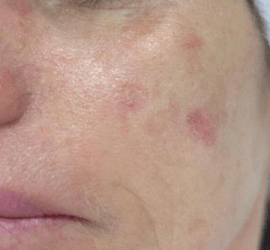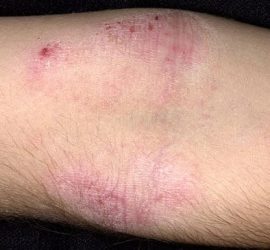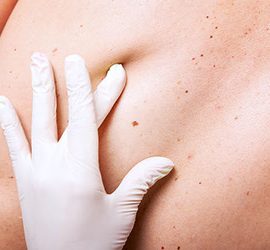MEDICAL DERMATOLOGY
At Complete Dermatology, we treat all types of skin condition regardless of the severity or age of the patient. Our award winning physicians are trained and experienced in the latest skin care treatment.

Acne
Acne is the most common skin condition, affecting teenagers as well as adults. It is not caused by poor hygiene or the foods that we eat, but rather by overproduction of oil that sticks to dead skin cells that becomes clogged in pores. Hormones also play a role in causing acne. Acne appears in different forms such as whiteheads, blackheads, inflamed pimples, and painful cysts. If acne is untreated, it may cause dark spots or even scars.
There are many effective ways of treating acne, such as topical creams and washes, oral medications, extractions, and chemical peels. It is important to see a dermatologist to evaluate your acne, because treating moderate to severe acne with over-the-counter topicals usually proves to be ineffective.
At the office visit, you will be given a unique treatment regimen based on the type and severity of your acne. We will also recommend a gentle skin care regimen to use during this time. It is important to follow this regimen as directed, because this can affect how quickly your skin improves. It is also important that you are patient with your progress because acne does not clear overnight.

Actinic Keratosis (AK)
Actinic Keratosis (AK), or precancerous spot, is a dry, scaly growth that occurs on the skin. Actinic keratoses are caused by prolonged exposure to ultraviolet rays from the sun or tanning booths. They usually occur after age 40, and are more common in people with fair skin. AKs are considered precancerous. If left untreated, they can turn in to a type of skin cancer called Squamous Cell Carcinoma. People with AKs should see a dermatologist regularly because they usually continue to occur throughout their lifetime.
We offer different options for treating Actinic Keratosis including Cryo Therapy (freezing with liquid nitrogen), topical therapies, and Photodynamic Therapy (PDT).
Watch our Patient Education Video to learn more.

Atopic Dermtitis/Eczema
Atopic dermatitis, or eczema, is a common skin condition that can affect people of all ages, but is most common in infants and children. Patients with eczema have dry, sensitive skin that periodically flares up with a red, itchy rash. Eczema can vary in severity and depending on the degree, may significantly impact the patient’s lifestyle and self-esteem. While the exact cause of eczema is not known, it has been found to run in families with seasonal allergies or asthma. In children and adults, eczema typically occurs on the face, neck, and along the insides of the elbows, knees, and ankles. In infants, it may primarily affect the face and scalp. There is currently no known cure for eczema. When you meet with one of our medical professionals, they will determine which treatment will most likely control its symptoms. We recommend preventative measures that can minimize the effects of eczema, such as daily use of moisturizers and avoiding triggers. There are also a variety of prescription medications that can be utilized to clear mild to severe disease. If you have moderate to severe eczema, it is especially important that you visit us regularly to watch for any associated complications, such as skin infections.

Psoriasis
Psoriasis is a chronic disease that is caused by the immune system sending faulty signals which cause skin cells to grow rapidly and form thick areas of scale. Psoriasis is not contagious. Psoriasis can appear at any age, but is most commonly diagnosed between 15 and 30 years of age. It can be triggered or worsened by a stressful event, strep infection, oral medication, weather changes, or trauma to the skin. Patients with psoriasis may also develop psoriatic arthritis, causing painful, stiff, or swollen joints. It usually occurs 5 to 12 years after the initial psoriasis diagnosis.
Treatment will vary depending on type and severity of psoriasis, and if the patient has joint involvement. We offer comprehensive treatment plans for patients with psoriasis including topical creams and ointments, oral medications, phototherapy, and a full range of injectable biologic medications.


Skin Cancer
Skin cancer can appear anywhere on the skin. It can be present but show different symptoms. It is difficult to distinguish a skin cancer from a harmless growth, therefore it is important to have your skin checked by a dermatologist at least once a year. You should make an appointment if you notice a new spot, or any spot that is growing, changing, or bleeding.
Basal Cell Carcinoma The most common type of skin cancer. They occur mostly in sun-exposed areas, and usually resemble a pimple or sore that won’t heal. They grow slowly, making it easy to treat.
Squamous Cell Carcinoma Very common type of skin cancer. It often appears on skin that has gotten lots of sun, but can appear on any part of the body. Squamous cell cancer can also appear on skin that was badly burned, received high doses of radiation (such as x-rays), or was exposed to strong chemicals. They are often scaly and have a reddish color, and can look like a sore this is not healing. Without treatment, this cancer can grow deeply and spread to other parts of the body.
Melanoma An aggressive type of skin cancer presented in an existing mole or can appear as a new mole. By performing skin checks on yourself, you will be able to spot any new or changing moles or spots. If caught early, melanoma is often curable. You should watch for:
– A mole on the skin that is growing, changing shape, or changing color.
– A mole that looks scaly, oozes, or bleeds.
– New dark spot on the skin that looks like a mole, but grows quickly.
– Dark color or streak underneath a fingernail or toenail.
If a patient has a suspicious spot, a biopsy will be done where a small sample of the lesion is taken. If the biopsy confirms a malignancy, there are many non-surgical and surgical treatments that the physician may recommend for treatment.

Vitiligo
Vitiligo is a skin condition that causes the skin to lose its pigment or color. It most commonly occurs on skin and hair, but rarely inside the mouth or eyes. It can occur at any age and affects all skin types. Vitiligo can spread or remain stable.
There is no cure, but treatments are available. The more common treatment option is a combination of topical corticosteroids, anti-inflammatories and the use of an excimer laser to help re-pigment the treated areas.

Warts
Warts are very common skin growths that are caused by the human papillomavirus (HPV). Warts are not cancerous, but are contagious, and can easily spread from person to person. They can occur anywhere on the body, and are often skin-colored and rough. Anyone can get warts, but children, teenagers, or people with weakened immune systems are more likely to get them. Treating warts can be difficult, as they can be stubborn and grow back. Therefore, multiple treatments may be necessary for complete removal. Treatment options include cryotherapy (freezing with liquid nitrogen), self-applied creams, and laser treatments.

